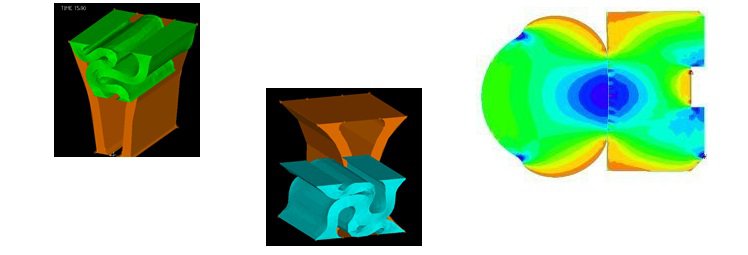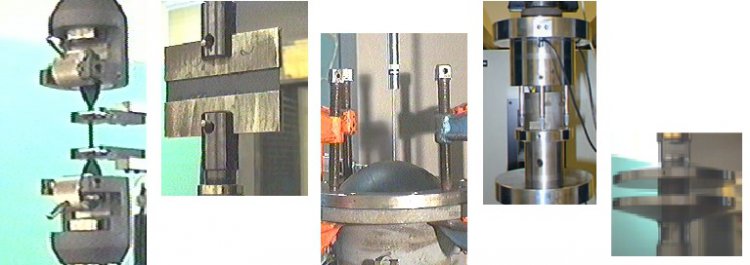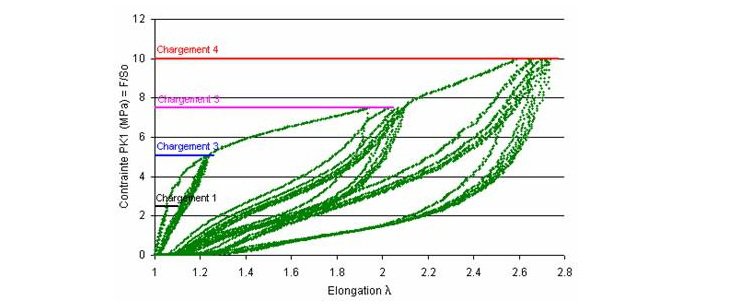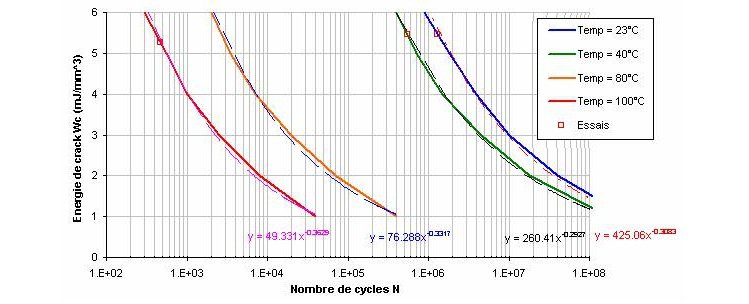Elastomer
ELASTOMER BEHAVIOUR
Cyclically loading an elastomer structure involves a number of complex phenomena that may possibly be coupled :
-
First of all, the non-linear, hyperelastic behaviour of the material;
-
Material accommodation (softening after a number of cycles);
-
Stiffening caused by the loading frequency;
-
Material internal heating caused by behaviour hysteresis;
-
Creep or structure relaxation;
-
Lastly, material fatigue due to cyclic stresses.

Calculating elastomer parts
1 - Material hyperelastic behaviour
If the part to be analysed is a rubber-like structure, its static behaviour may be modelled using hyperelastic laws (Gent, 1958). Depending on the deformation ratio that may be achieved in the structure, a number of forms of laws may be used (Neo-Hooke, Mooney-Rivlin, Ogden, Arruda-Boyce, etc.) (Arruda, 1993). The choice of the hyperelastic potential must be made at the time of the modelling, after an analysis of mechanical tests performed on test samples.
It should be noted that these tests must be different (in terms of deformation invariants), so as to cover a wide multi-axialfield. Generally, we recommend performing single-axial traction tests, compression tests or equi-biaxial traction tests along with shear tests.

Elastomer material characterization tests
Compressibility tests are generally performed. This is because even if elastomer materials are deemed incompressible, they are never completely so, it all depends on the level of compression applied.
2 - Accommodation (or Mullins effect)
This is the material's ability to "memorize" the maximum energy level reached (Treloar, 1975). In practice, in an elastomer structure and even if initially the material characteristics are identical at every point, after applying a force the material elements will have a different “memory”.
Consequently, their behaviour laws will be different after a few cycles. This accommodation can be modelled from data drawn from mechanical tests (refer to the Ogden-Roxburg model). Mechanical tests must therefore be performed and cycled at different load levels.

Illustration of the Mullins effect
3 - Stiffening caused by the loading frequency
The viscous nature of elastomer materials gives them a dynamic behaviourthat is analogous to that of a damper. The frequency and the strain placed on them (especially in the case of vibrations), may lead to the material stiffening.
Nevertheless, it is possible to take this effect into account by performing material tests at the strain frequencies.
4 - Internal heating
The viscous nature of these materials also gives them a hysteretic behaviour. This difference in behaviour between loading and unloading causes a loss of energy in the material that is transformed into heat. Their insulating nature may then "trap" this heat and lead to a thermal divergence (overheating).
We should also note that an increase in temperature may also accelerate the aging/creeping/relaxation precisely in those areas subject to the greatest strain.

Internal heating of an elastomer wheel band
5 - Creep or structure relaxation
The viscous behaviour of elastomers leads to a loss of material rigidity under the application of a static load. In hyperelastic materials, this loss of rigidity is a function of the level of energy in the material (Holzapfel, 1996). This is why there is a need for mechanical creep (or relaxation) tests at various levels of stress (or deformation).
As in the "hyperelastic behaviour" section, these tests must be conducted rigorously with various levels of multiaxiality (Holzapfel, 2000 and 2001).
6 - Fatigue
Just like all materials, the presence of (inevitable) defects in a structure subject to cyclic strains means that these defects may propagate until the structure fails. Currently, the models put forward by some authors, Mars, Saintier, Verron, Layouni, Gruand, etc. (Mars, 2001 and 2004; Saintier, 2001; Gruand, 2006), are not yet unanimously accepted, even if this opens up paths for research. The efficiency of the formulations has yet to be proven (when they are accessible and therefore not confidential).
We can however note that the fatigue behaviour of these materials is highly dependent on the operating temperature. Consequently, to get an idea of fatigue related behaviour, it is necessary to run mechanical tests with different energy levels and a variety of test temperatures (ideally and so as to cover a set of invariants, just like in static cases, various tests should also be applied).

Fatigue approach using crack energy
7 - Couplings
Lastly, all of these phenomena may also be coupled. The temperature acts on material rigidity, accelerating creep, accelerating fatigue, etc. Creep modifies material rigidity, thereby changing the structure's response to stresses and modifying the structure's thermal behaviour, etc.
8 - Bibliography
ARRUDA E.M. AND BOYCE M. C., "A three-dimensional constitutive model for the large stretch behaviour of rubber elastic materials", J. Mech. Phys. Solids, Vol. 41 (2), pp 389-412 (1993).
ELASTOMER CRITERIA FOR ENGINEERING DESIGN, Edited by C Hepburn and R.J.Reynolds, Applied science publishers.
GENT AND THOMAS, "Forms of the stored strain energy function for vulcanized Rubber", J. Polym Sci., Vol. 28, pp. 625-637, 1958.
HOLZAPFEL G. A., "On large strain viscoelasticity: continuum formulation and finite element applications to elastomeric structures", Int. J. Num. Meth. Engng., Vol. 39, pp 3903-3926, 1996.
HOLZAPFEL G. A, "Nonlinear solid mechanics. A continuum approach for engineering". John Wiley & Sons, Chichester, pp 278-295, 2000.
HOLZAPFEL G. A, "Biomechanics of soft tissue", in Lemaitre (ed.), Handbook of Materials Behavior Models: Nonlinear Models and Properties, Academic Press, 2001, pp 1057-1071.
LAIARINANDRASANA L., MUNERA D. D ET GRUAND R. Creep damage mechanisms and fracture mechanics applied on aged and non aged polyamide 66 [Revue]. - Rolduc Abbey, Kerkrade, The Netherlands : [s.n.], 2006. - Vol. 13th International Conference on Deformation, Yield and Fracture of Polymers.
MARS W.V., 08-2001, Dissertation, Multiaxial fatigue of rubber.
MARS W.V.Multiaxial fatigue crack initiation in rubber, Tire science and technology, TSTCA, Vol 29, n°3, July September 2001, pp 171-185.
MARS AND FATEMI "A novel specimen for investigating the mechanical behaviour of elastomers under multiaxial loading conditions, Society for experimental mechanics, page 136-146, vol 44, n°2, 04/2004.
SAINTIER N. Fatigue multiaxiale dans un élastomère de type NR charge : mécanismes d'endommagement et critère local d'amorçage de fissure, thèse 2001.
TRELOAR L.R.G, 3rd edition, the physics of Rubber elasticity, Clarendon Press Oxford, 1975.

